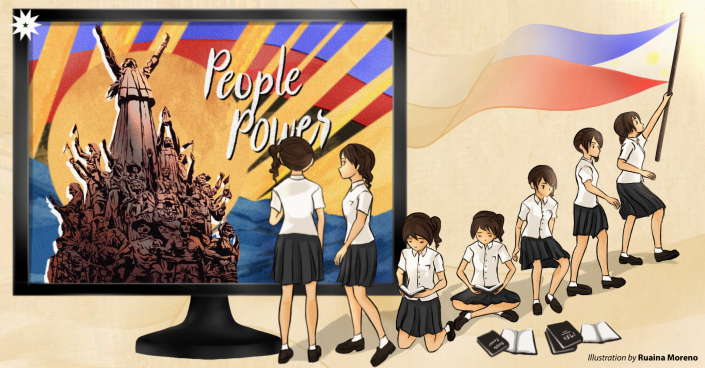
To commemorate the 35th anniversary of the 1986 People Power Revolution, speakers from different generations shared their insights on the historic movement in Rekindling People Power: A Kapihan ng Malalayang Lasalyano Forum, an online seminar hosted by the Office of the Vice President for Lasallian Mission last February 26 on Facebook live.
Information gap
As 35 years have passed since the 1986 EDSA Revolution, many, especially among the youth, learn about the event through their education or self-research. University Student Government President Maegan Ragudo explained that this gap has allowed a “big misinformation campaign” to blossom especially on what had transpired during the Martial Law era, which she pointed out is sometimes referred to as the “Golden Age of the Philippines”.
National Historical Commission of the Philippines researcher Kristoffer Pasion pointed to YouTube as one of the propagators of misinformation, as the platform has become a hotbed for conspiracy theories that were mostly propaganda.
He argued that the current educational setup dissuades people from asking questions. “Pagdating sa historical education, we are bombarded with dates instead of asking the question why,” he said. “When asking the question why in discussions, that is basically Araling Panlipunan’s essence…the abolition of asking the why question sometimes is dangerous.”
“We really need to make sense [of] these narratives…lalo na sa youth, kasi kahit sa atin (older generation) ang hirap din minsan intindihin kasi ang complex ng ibang mga issue,” furthered Department of Communication associate professor Dr. Jason Cabañes.
(Especially to the youth, because it’s sometimes hard even for our generation to understand these complex issues.)
Meanwhile, for De La Salle Philippines President Edgar Chua, the youth can exercise critical thinking by asking their teachers open-ended questions. In this way, a student can truly feel and empathize with the past as they delve deeper into history’s true principle.
‘A transfer of power’ between elites
The 1986 EDSA Revolution is arguably best known for ousting Ferdinand Marcos, a dictator who held power over the country for more than two decades. But Ragudo revealed that she does not see it as a revolution but instead as a “transfer of power from one elite to another,” urging the audience to reflect on its impact today. “To this day, we can still feel the effects of not only Martial Law, but ‘yung kakulangan ng People Power in helping out institutions fully democratize.”
Chua, who partook in the EDSA Revolution, disagreed with Ragudo. “We really were looking at a genuine change in governance and the way the country was being run,” he said, pointing out that being able to hold the EDSA forum itself is proof that the movement was a success.
He reminded viewers to remain steadfast in protecting the power of the people, as he argued that the current government has become more “repressive” and hopes the country would not go back to “the same situation we had before People Power.”
Personality politics
According to Wayne Akeboshi, a COSCA-LOVE and DLSU Red Cross Youth Volunteer who moderated the forum, personality politics has deeply influenced the way people think about the EDSA Revolution. “When we talk to people with strong opposing views,” he said, “we quickly fall into the trap of dismissive tones, dismissive narratives, or linear narratives na parang dini-dismiss natin yung sentiments of these people.”
Pasion further expounded that the EDSA Revolution cannot be defined based on political figures alone as they do not fully represent the revolution. Instead, the collective effort and courage of the masses to reclaim the democracy that was once stolen from them.
“Political parties aren’t what the revolution is all about,” Chua summarized. “It is about the people who successfully overthrew Marcos’ dictatorship.
Ragudo concluded by stressing the importance of inquiry and curiosity over mere memorization of historical facts. Asking essential questions to further understand what happened during the EDSA Revolution is necessary to understand the “true essence” of the event, she added.
Quoting the rallying cry from the revolution, host Anna Givera said, “Tayo ang EDSA; tayo ang pag-asa.”
(We are EDSA; we are hope.)
